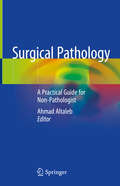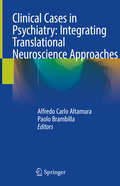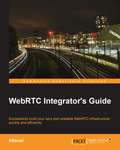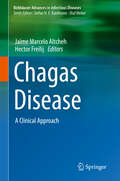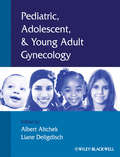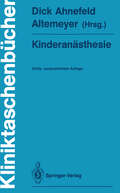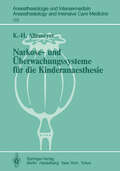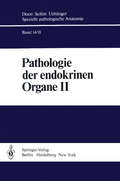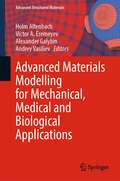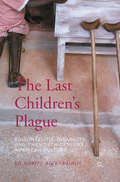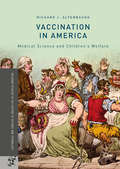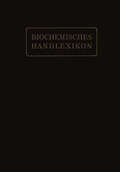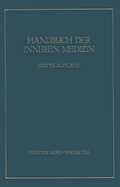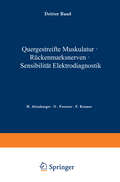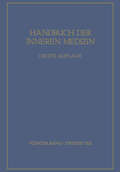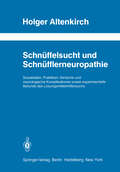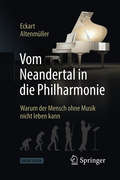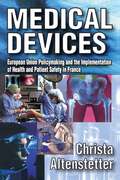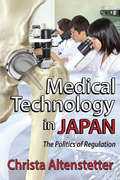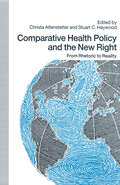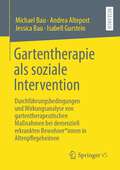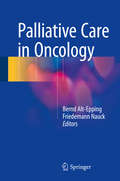- Table View
- List View
Surgical Pathology: A Practical Guide for Non-Pathologist
by Ahmad AltalebThis book provides a practical and clinically oriented guide to the concepts of pathologic diagnosis of surgical specimens. Concise and highly illustrated chapters cover essential information required within patient management. Telepathology, ancillary techniques, and surgical oncology concepts are also examined.Surgical Pathology: A Practical Guide aims to bridge the knowledge gap between surgeons and pathologists to promote mutual understanding and a better working relationship. This book is relevant to general surgeons, and surgical oncologists, whether in training or in practice. It also serves as an introduction for first-year pathology residents, and medical students interested in surgical pathology.
Clinical Cases in Psychiatry: Integrating Translational Neuroscience Approaches
by Alfredo Carlo Altamura Paolo BrambillaThis case series book offers a practical and accessible approach to psychiatry, addressing major clinical problems ranging from psychosis to aging effects, each of which is tackled as it arises in everyday settings. With its emphasis on everyday practice strongly linked to underlying theory, the book combines clinical knowledge with the realities of managing clinical problems, and will provide a basis for developing sound analytical and confident decision-making skills. Presenting different visions of clinical psychiatry and expanding psychiatrists’ interventions by integrating innovative neuroscience approaches such as neuroimaging, neuropsychology, TMS and cognitive rehabilitation, it will help clinicians and students alike gain a sound understanding of the wide range of signs and symptoms that indicate psychiatric disorders, and how the diagnosis, management and treatment options can differ from those in other medical specialties. The volume includes learning activities, with questions on each clinical case followed by detailed explanatory answers, and self-assessment exercises to assist with learning and revision. Throughout the book, tips and key features are highlighted with boxes, algorithms, tables and figures, which the reader can refer back to for exam revision and well into her/his career.
WebRTC Integrator's Guide
by AltanaiThis book is for programmers who want to learn about real-time communication and utilize the full potential of WebRTC. It is assumed that you have working knowledge of setting up a basic telecom infrastructure as well as basic programming and scripting knowledge.
Chagas Disease: A Clinical Approach (Birkhäuser Advances in Infectious Diseases)
by Jaime Marcelo Altcheh Hector FreilijChagas disease is a potentially life threatening condition that was historically mainly endemic to Latin America. Over the last decade, however, the disease has spread to and is increasingly prevalent in other continents such as North America and Europe, with an estimated 7 million people infected worldwide. It is primarily transmitted by insect vectors that carry the parasite Trypanosoma cruzi, the disease agent. In areas where there is vector control and in non-endemic countries, it is mainly transmitted via congenital infection. Cardiac and gastrointestinal complications are common in untreated individuals.This book offers a comprehensive overview of Chagas disease, including its vectorial and congenital transmission, and molecular diagnosis, which is essential for screening, and developing and providing timely, effective anti-trypanosomal treatment. Written by experts working with infected patients on a daily basis, it discusses the pathogenesis of congenital, cardiac, gastrointestinal and oral Chagas disease, as well as its treatment and the pharmacological aspects of drug development in this area.Chapter "Chagas Disease Treatment Efficacy Biomarkers: Myths and Realities" is available open access under a via link.springer.com.
Pediatric, Adolescent and Young Adult Gynecology
by Albert Altchek Liane DeligdischThe young ob/gyn patient presents unique problems different from the mature woman but which training often neglects. This user-friendly, practical book provides generous coverage of all aspects of pre-womanhood gynecology. Ranging from the commonest problems to the less common but urgent, it emphasizes diagnosis, special care and management throughout.
Kinderanästhesie (Kliniktaschenbücher)
by K. H. Altemeyer K. D. Bachmann U. Bauer-Miettinen P. Dangel H. Darius W. Dick T. Fösel J. Hausdörfer J. Holzki G. Jorch U. Kleinheisterkamp G. Kraus F. J. Kretz R. Ließem-Sachse K. Mantel K. Schrör H. StopfkuchenDas Buch gibt in didaktisch übersichtlicher Form einen ausgezeichneten Einblick in das Gebiet der Kinderanästhesie. In der vollständig überarbeiteten 3. Auflage dieses bewährten Taschenbuchs wurden die aktuellen Entwicklungen berücksichtigt. Alle Kapitel wurden auf den neuesten Stand gebracht sowie ein Kapitel über Regionalanästhesie neu aufgenommen. Im Bereich der kardiopulmonaren Reanimation finden die neuesten Empfehlungen der American Heart Association Berücksichtigung. Das Taschenbuch eignet sich hervorragend als Informationsgrundlage und Überblick für Anästhesisten und Pflegepersonal in der Weiterbildung sowie für Studenten höherer Semester und vermittelt außerdem Pädiatern und Kinderchirurgen Verständnis für die Probleme des jeweils anderen Fachgebiets. Aus den Besprechungen: "... Allen Ärzten, im besonderen Pädiatern und Anästhesisten, denen Neugeborene, Säuglinge und Kleinkinder, die operiert werden müssen, anvertraut werden, ist dieses Büchlein als wertvoller Wegweiser bei der praktischen Tätigkeit wärmstens zu empfehlen." Wiener klinische Wochenschrift #1
Narkose- und Überwachungssysteme für die Kinderanaesthesie: Experimentelle und klinische Untersuchungen zur Bewertung und Neuentwicklung (Anaesthesiologie und Intensivmedizin Anaesthesiology and Intensive Care Medicine #170)
by Karl-Heinz AltemeyerPathologie der endokrinen Organe (Spezielle pathologische Anatomie #14)
by E. Altenähr W. Böcker G. Dhom W. Gusek P. U. Heitz G. Klöppel H. Lietz H. Mitschke W. Saeger H.-J. Schäfer J.-J. Staub H. SteinerAdvanced Materials Modelling for Mechanical, Medical and Biological Applications (Advanced Structured Materials #155)
by Holm Altenbach Victor A. Eremeyev Alexander Galybin Andrey VasilievThe book is devoted to the 70th birthday of Prof. Sergey M. Aizikovich, which will celebrated on August 2nd 2021. His scientific interests are related to the following topics: Mechanics of contact interactions, Functionally graded materials, Mechanics of fracture, Integral equations of mathematical physics, Inverse problems of the theory of elasticity, and Applications of elasticity to biological and medical problems of mechanics of materials. The papers, collected in the book, are contributions of authors from 10 countries.
The Last Children’s Plague: Poliomyelitis, Disability, and Twentieth-Century American Culture
by Richard J. AltenbaughPoliomyelitis, better known as polio, thoroughly stumped the medical science community. Polio's impact remained highly visible and sometimes lingered, exacting a priceless physical toll on its young victims and their families as well as transforming their social worlds. This social history of infantile paralysis is plugged into the rich and dynamic developments of the United States during the first half of the twentieth century. Children became epidemic refugees because of anachronistic public health policies and practices. They entered the emerging, clinical world of the hospital, rupturing physical and emotional connections with their parents and siblings. As they underwent rehabilitation, they created ward cultures. They returned home to occasionally find hostile environments and always discover changed relationships due to their disabilities. The changing concept of the child, from an economic asset to an emotional commitment, medical advances, and improved sanitation policies led to significant improvements in child health and welfare. This study, relying on published autobiographies, memoirs, and oral histories, captures the impact of this disease on children's personal lives, encompassing public-health policies, hospitalization, philanthropic and organizational responses, physical therapy, family life, and schooling. It captures the anger, frustration, and terror not only among children but parents, neighbors, and medical professionals alike.
Vaccination in America: Medical Science and Children’s Welfare (Palgrave Studies in the History of Science and Technology)
by Richard J. AltenbaughThe success of the polio vaccine was a remarkable breakthrough for medical science, effectively eradicating a dreaded childhood disease. It was also the largest medical experiment to use American schoolchildren. Richard J. Altenbaugh examines an uneasy conundrum in the history of vaccination: even as vaccines greatly mitigate the harm that infectious disease causes children, the process of developing these vaccines put children at great risk as research subjects. In the first half of the twentieth century, in the face of widespread resistance to vaccines, public health officials gradually medicalized American culture through mass media, public health campaigns, and the public education system. Schools supplied tens of thousands of young human subjects to researchers, school buildings became the main dispensaries of the polio antigen, and the mass immunization campaign that followed changed American public health policy in profound ways. Tapping links between bioethics, education, public health, and medical research, this book raises fundamental questions about child welfare and the tension between private and public responsibility that still fuel anxieties around vaccination today.
Vaccination in America: Medical Science and Children’s Welfare (Palgrave Studies in the History of Science and Technology)
by Richard J. AltenbaughThe success of the polio vaccine was a remarkable breakthrough for medical science, effectively eradicating a dreaded childhood disease. It was also the largest medical experiment to use American schoolchildren. Richard J. Altenbaugh examines an uneasy conundrum in the history of vaccination: even as vaccines greatly mitigate the harm that infectious disease causes children, the process of developing these vaccines put children at great risk as research subjects. In the first half of the twentieth century, in the face of widespread resistance to vaccines, public health officials gradually medicalized American culture through mass media, public health campaigns, and the public education system. Schools supplied tens of thousands of young human subjects to researchers, school buildings became the main dispensaries of the polio antigen, and the mass immunization campaign that followed changed American public health policy in profound ways. Tapping links between bioethics, education, public health, and medical research, this book raises fundamental questions about child welfare and the tension between private and public responsibility that still fuel anxieties around vaccination today.
Biochemisches Handlexikon: V. Band: Alkaloide, Tierische Gifte, Produkte der inneren Sekretion, Antigene, Fermente
by H. Altenburg I. Bang K. Bartelt Fr. Baum C. Brahm W. Cramer K. Dieterich R. Ditmar M. Dohrn H. Einbeck H. Euler E. St. Faust C. Funk O. v. Fürth O. Gerngross V. Grafe J. Helle O. Hesse K. Kautzsch Fr. Knoop R. Kobert J. Lundberg C. Neuberg M. Nierenstein O. A. Oesterle Th. B. Osborne L. Pincussohn H. Pringsheim K. Raske B. v. Reinbold Br. Rewald A. Rollett P. Rona H. Rupe Fr. Samuely H. Scheibler J. Schmid J. Schmidt E. Schmitz M. Siegfried E. Strauss A. Thiele G. Trier W. Weichardt R. Willstätter A. Windaus E. Winterstein Ed. Witte G. Zemplén E. Zunz Emil AbderhaldenDieser Buchtitel ist Teil des Digitalisierungsprojekts Springer Book Archives mit Publikationen, die seit den Anfängen des Verlags von 1842 erschienen sind. Der Verlag stellt mit diesem Archiv Quellen für die historische wie auch die disziplingeschichtliche Forschung zur Verfügung, die jeweils im historischen Kontext betrachtet werden müssen. Dieser Titel erschien in der Zeit vor 1945 und wird daher in seiner zeittypischen politisch-ideologischen Ausrichtung vom Verlag nicht beworben.
Krankheiten des Nervensystems (Handbuch der inneren Medizin #5)
by H. Altenburger R. Bing G. Bodechtel A. Bostroem O. Bumke H. Curschmann F. Curtius F. Hiller J. Lange F. Lüthy K.v. Sántha H. Scheller R. Siebeck V. v. WeizsäckerDieser Buchtitel ist Teil des Digitalisierungsprojekts Springer Book Archives mit Publikationen, die seit den Anfängen des Verlags von 1842 erschienen sind. Der Verlag stellt mit diesem Archiv Quellen für die historische wie auch die disziplingeschichtliche Forschung zur Verfügung, die jeweils im historischen Kontext betrachtet werden müssen. Dieser Titel erschien in der Zeit vor 1945 und wird daher in seiner zeittypischen politisch-ideologischen Ausrichtung vom Verlag nicht beworben.
Quergestreifte Muskulatur · Rückenmarksnerven · Sensibilität Elektrodiagnostik (Handbuch der Neurologie #3)
by H. Altenburger O. Foerster F. Kramer V.v. WeizsäckerDieser Buchtitel ist Teil des Digitalisierungsprojekts Springer Book Archives mit Publikationen, die seit den Anfängen des Verlags von 1842 erschienen sind. Der Verlag stellt mit diesem Archiv Quellen für die historische wie auch die disziplingeschichtliche Forschung zur Verfügung, die jeweils im historischen Kontext betrachtet werden müssen. Dieser Titel erschien in der Zeit vor 1945 und wird daher in seiner zeittypischen politisch-ideologischen Ausrichtung vom Verlag nicht beworben.
Spezielle Pathologie 2 (Handbuch der inneren Medizin #T. 2 )
by H. Altenburger Gustav von Bergmann Leo MohrDieser Buchtitel ist Teil des Digitalisierungsprojekts Springer Book Archives mit Publikationen, die seit den Anfängen des Verlags von 1842 erschienen sind. Der Verlag stellt mit diesem Archiv Quellen für die historische wie auch die disziplingeschichtliche Forschung zur Verfügung, die jeweils im historischen Kontext betrachtet werden müssen. Dieser Titel erschien in der Zeit vor 1945 und wird daher in seiner zeittypischen politisch-ideologischen Ausrichtung vom Verlag nicht beworben.
Schnüffelsucht und Schnüfflerneuropathie: Sozialdaten, Praktiken, klinische und neurologische Komplikationen sowie experimentelle Befunde des Lösungsmittelmißbrauchs (Schriftenreihe Neurologie Neurology Series #23)
by Holger AltenkirchVom Neandertal in die Philharmonie: Warum der Mensch ohne Musik nicht leben kann
by Eckart AltenmüllerWarum haben wir Menschen Musik? Wie entfaltet Musik ihre Wirkung? Was geht dabei in unserem Gehirn vor? Fördert Musik die Intelligenz? Dient sie dem Gruppenzusammenhalt? Teilt Musik Emotionen mit? Dieses Buch erklärt die zahlreichen Wirkungen von Musik auf Fühlen und Denken, auf die Organisation von Gruppen sowie auf unsere körperliche und geistige Gesundheit. Im ersten Teil des Werkes werden die evolutionären Grundlagen der Musikwahrnehmung und des Musizierens dargestellt. Die faszinierenden neuen Erkenntnisse zu den positiven, aber auch den negativen Auswirkungen intensiven Musizierens auf das Nervensystem werden in den folgenden Kapiteln geschildert. Glücklicherweise macht Musik nur selten krank – viel wichtiger sind die bislang noch gar nicht ausgeschöpften heilenden Potenziale und die große Macht der positiven Emotionen, die durch Musik ausgelöst werden. Mit diesen erfreulichen und zukunftsweisenden Aspekten schließt das Buch, das jeden ansprechen wird, der eine Liebe zur Musik empfindet, sei es als Musizierender oder als Hörer.
Medical Devices: European Union Policymaking and the Implementation of Health and Patient Safety in France
by Christa AltenstetterMedical devices are the bread and butter from which health care and clinical research are derived. Such devices are used for patient care, genetic testing, clinical trials, and experimental clinical investigations. Without medical devices, there is no clinical research or patient care. Without life-adjusting devices, there are no medical procedures or surgery. Without life-saving and life-maintaining devices, there is no improvement in well-being and quality of life. Without innovative medical devices and experimentation, there can be no medical progress or patient safety. Medical devices and medical technology are used to create or support many different products and medical-surgical procedures. This volume on the regulation of medical devices in the European Union, with a focus on France, tackles a topic of interdisciplinary interest and significance for policymakers in countries around the globe. The EU regulatory regime is one of three global regional regimes, and medical products manufactured in EU countries are sold worldwide. As countries confront an aging population on a global scale, with associated increases in chronic diseases, physical handicaps, and multi-morbidity, there will inevitably be an increase in the demand for health services and, concomitantly, the use of medical devices in medical and surgical procedures. This will be the case regardless of whether services are delivered in hospitals, doctors' offices, or at home. The associated risks of a particular device will be the same whatever the country of origin for the device, or where the need occurs. Revolutionary medical advances increase diagnostic capabilities, but they increase the potential of harm and risks to patients. Medical technologies and devices are used ethically most of the time; yet they have the potential for unethical use when scientific medicine is elevated over human life and death. Assumptions that are taken for granted can be dangerous to a patient's health. That is why our understanding of appropriate and effective regulation of medical devices is significant to all people on all continents.
Medical Devices: European Union Policymaking and the Implementation of Health and Patient Safety in France
by Christa AltenstetterMedical devices are the bread and butter from which health care and clinical research are derived. Such devices are used for patient care, genetic testing, clinical trials, and experimental clinical investigations. Without medical devices, there is no clinical research or patient care. Without life-adjusting devices, there are no medical procedures or surgery. Without life-saving and life-maintaining devices, there is no improvement in well-being and quality of life. Without innovative medical devices and experimentation, there can be no medical progress or patient safety. Medical devices and medical technology are used to create or support many different products and medical-surgical procedures. This volume on the regulation of medical devices in the European Union, with a focus on France, tackles a topic of interdisciplinary interest and significance for policymakers in countries around the globe. The EU regulatory regime is one of three global regional regimes, and medical products manufactured in EU countries are sold worldwide. As countries confront an aging population on a global scale, with associated increases in chronic diseases, physical handicaps, and multi-morbidity, there will inevitably be an increase in the demand for health services and, concomitantly, the use of medical devices in medical and surgical procedures. This will be the case regardless of whether services are delivered in hospitals, doctors' offices, or at home. The associated risks of a particular device will be the same whatever the country of origin for the device, or where the need occurs. Revolutionary medical advances increase diagnostic capabilities, but they increase the potential of harm and risks to patients. Medical technologies and devices are used ethically most of the time; yet they have the potential for unethical use when scientific medicine is elevated over human life and death. Assumptions that are taken for granted can be dangerous to a patient's health. That is why our understanding of appropriate and effective regulation of medical devices is significant to all people on all continents.
Medical Technology in Japan: The Politics of Regulation
by Christa AltenstetterJapan is suffering from a "device gap." Compared to its American and European counterparts, Japan lags in adopting innovative medical devices and making new treatments and procedures available to its patients. Many blame its government and bureaucracy for Japan's delayed access to modern medicine and new medical devices. Christa Altenstetter examines the contextual social, historical, and political conditions of Japan's medical field to make sense of the state of the country's medical profession and its regulatory framework. She explores the development of regulatory frameworks and considers possibilities for eventual reform and modernization. More specifically, Altenstetter looks into how physicians and device companies connect to the government and bureaucracy, the relationships connecting Japanese patients to their medical system and governmental bureaucracy, and how the relationships between policymakers and the medical profession are changing. The issues addressed here are becoming increasingly relevant as numerous countries in Asia, Latin America, and Central and Eastern Europe are only now beginning to regulate medical technology, following the lead of the US and the European Union. Those interested in global medicine and Asian studies will find this book both informative and compelling.
Medical Technology in Japan: The Politics of Regulation
by Christa AltenstetterJapan is suffering from a "device gap." Compared to its American and European counterparts, Japan lags in adopting innovative medical devices and making new treatments and procedures available to its patients. Many blame its government and bureaucracy for Japan's delayed access to modern medicine and new medical devices. Christa Altenstetter examines the contextual social, historical, and political conditions of Japan's medical field to make sense of the state of the country's medical profession and its regulatory framework. She explores the development of regulatory frameworks and considers possibilities for eventual reform and modernization. More specifically, Altenstetter looks into how physicians and device companies connect to the government and bureaucracy, the relationships connecting Japanese patients to their medical system and governmental bureaucracy, and how the relationships between policymakers and the medical profession are changing. The issues addressed here are becoming increasingly relevant as numerous countries in Asia, Latin America, and Central and Eastern Europe are only now beginning to regulate medical technology, following the lead of the US and the European Union. Those interested in global medicine and Asian studies will find this book both informative and compelling.
Comparative Health Policy and the New Right: From Rhetoric to Reality
by Christa Altenstetter Stuart C. HaywoodA compilation of essays which examine the response of the new Right to health policy issues. While economic circumstances dictate the pressures placed on policy-makers, it is argued that there is a gap between the rhetoric they espouse and the actions/initiatives taken.
Gartentherapie als soziale Intervention: Durchführungsbedingungen und Wirkungsanalyse von gartentherapeutischen Maßnahmen bei demenziell erkrankten Bewohner*innen in Altenpflegeheimen
by Andrea Altepost Michael Bau Jessica Bau Isabell GursteinDas ILAG – Institut Leistung Arbeit Gesundheit ist ein interdisziplinär arbeitendes sozialwissenschaftliches Forschungsinstitut und führt seit 2007 Untersuchungen zu Fragen der Gesundheit und zur Veränderung von Arbeit im demografischen und digitalen Wandel durch.
Palliative Care in Oncology
by Bernd Alt-Epping Friedemann NauckPalliative care provides comprehensive support for severely affected patients with any life-limiting or life-threatening diagnosis. To do this effectively, it requires a disease-specific approach as the patients’ needs and clinical context will vary depending on the underlying diagnosis. Experts in the field of palliative care and oncology describe in detail the needs of patients with advanced cancer in comparison to those with non-cancer disease and also identify the requirements of patients with different cancer entities. Basic principles of symptom control are explained, with careful attention to therapy for pain associated with either the cancer or its treatment and to symptom-guided antineoplastic therapy. Complex therapeutic strategies for palliative cancer patients are highlighted that involve both cancer- and symptom-directed options and address a range of therapeutic aims. Issues relating to drug use in palliative cancer care are fully explored, and a separate section is devoted to care in the final phase. A range of organizational and policy issues are also discussed, and the book concludes by considering likely future developments in palliative care for cancer patients. Palliative Care in Oncology will be of particular interest to palliative care physicians who are interested in broadening the scope of their disease-specific knowledge, as well as to oncologists who wish to learn more about modern palliative care concepts relevant to their day-to-day work with cancer patients.
